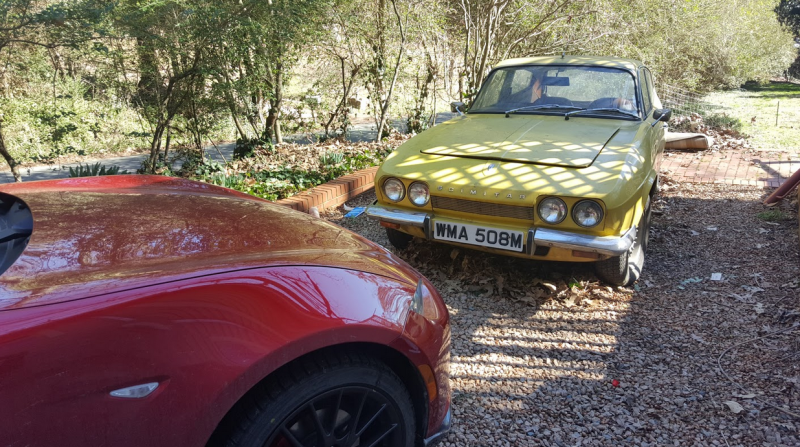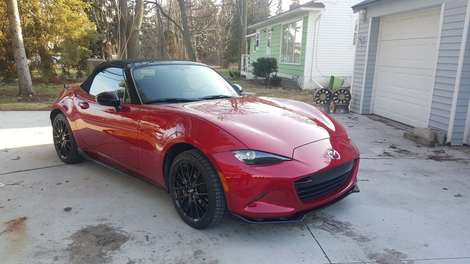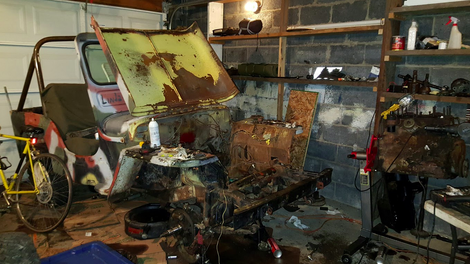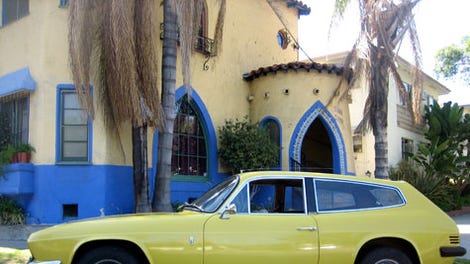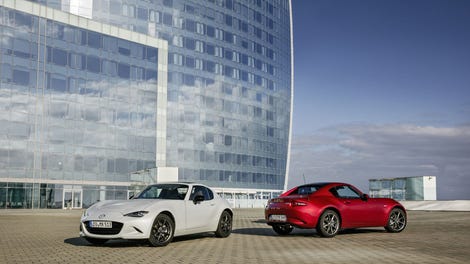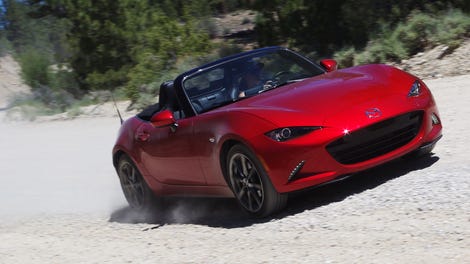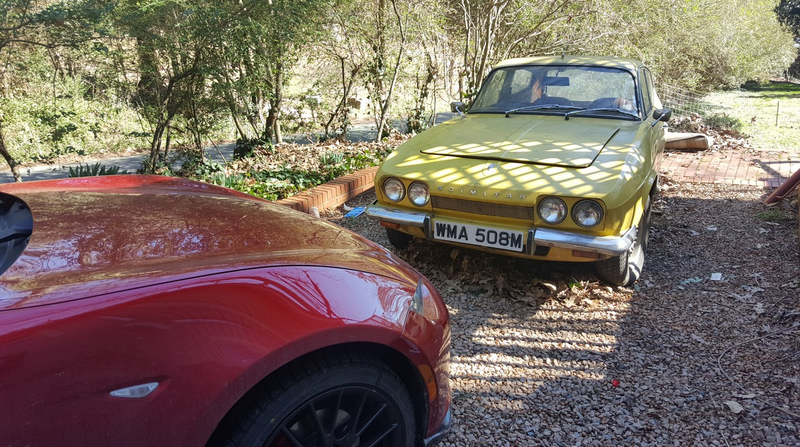
As someone who had never experienced the brilliance of the Mazda Miata, I asked readers last week what I should do with my gorgeous red press car, and the answers all said more or less the same thing: find great roads and drive until you drop.
So I packed my things and drove east towards North Carolina in search of such roads, and to wrench on an old British shooting brake. I quickly learned why the answer is always Miata.
Advertisement
Advertisement
The purpose of my trip was actually threefold: I had to stop by Charlottesville to see if my brother could help me rebuild my Willys generator, which I needed to get into tip-top shape for my 2,000 mile road trip in April. After that, my plan was to check out an eclectic Japanese car collection a reader had emailed me about, and then finally, this trip was supposed to bring my wrenching skills head to head with a severely-neglected Reliant Scimitar.
So I packed up my tools and a week’s worth of clothing, shoved it all into the Miata’s little trunk, and headed east.
It didn’t take much seat time to realize that the Miata isn’t a great highway cruiser. The wind noise from the soft-top had me constantly wondering whether I’d left a window open; the steering’s light precision on twisty roads was great, but on the freeway, it meant I often found myself wandering out of the lane; and the short wheelbase caused the car to pitch over bumpy roads, making the ride a bit choppy for long jaunts.
Sponsored
I found the infotainment system, too, to be a genuine pain in the butt. The controls don’t feel very intuitive, and they’re positioned right where my elbow wants to be, so I often inadvertently changed channels and muted the volume, missing crucial seconds of the Virginia-Virginia Tech basketball game I was listening to.
So the highway portion of this trip, despite my 34 MPG average, was not great, but honestly, for a little two-door sports car, it was better than I expected. Luckily, after six hours, I hit West Virginia and ditched the big roads for the snaky ones, just as the gods intended.
There was one road in particular that I’ll never forget. It was called Paint Creek Road, and it ran along a twisty creek on one side, and a heavily-wooded hillside on the other. A beautifully maintained route riddled with elevation changes and tight switchbacks, Paint Creek Road brought the Miata back into its element after far too many hours of painfully boring, loud highway cruising.
Advertisement
Advertisement
The little 2.0-liter inline-four— a fairly average engine in any other car, really— twisted the Miata’s rear tires with fervor. Between that nice exhaust sound, the push from that scrappy little 155 horsepower inline-four, the precise steering, and the curb weight that laughed in the face of centripetal acceleration, the Miata and I wreaked havoc on Paint Creek Road, and I immediately forgot about the car’s unremarkable highway manners.
Eventually, Paint Creek Road came to an end, and the Miata and I had to get back onto the highway for a bit until we arrived in Charlottesville, Virginia, home of Thomas Jefferson’s University of Virginia, a beautiful school that I never had a chance to enjoy since I was perpetually working on engineering problem-sets.
Once there, my brother Tom and I got cracking on my 1948 Willys CJ-2a’s six-volt generator, a 40-pound iron hulk that wasn’t producing any juice and risked bringing my Moab project to a screeching halt. The fate of my project was in Tom’s hands. No pressure.
What we found inside the generator was insulation that had deteriorated over the years, likely causing the field coil to ground with the casing:
The wire-harness that connects to the generator was also completely toast, as was some of the insulation at the top of the armature.
The bearings, luckily, were in nice shape, so we just wrapped the field coils with tape, painted some insulation on the armature, sanded a few contacts, replaced the wire harness, ran a couple of tests for continuity and buttoned it all up.
After (hopefully) fixing the generator, I drove the Miata down to Chapel Hill to meet up with my coworker Jason Torchinsky. Together, he and I had a great time in the Miata on the sinusoidal roads of the Blue Ridge Mountains, as we made our way to perhaps the greatest secret Japanese car collection in America.
But the most exciting part of the trip, for me, was working on the Reliant Scimitar, which Jason had been neglecting approximately since the end of the Civil War.
Advertisement
Advertisement
I assured Jason that we’d get his old car (which actually looks great on the outside) going without issue— it probably just needed a carb cleaning, maybe some cleaned points, and a little bit of light oil to loosen up those piston rings, I told him.
But I was wrong. Very wrong.
The wrenching started out as badly as any project possibly could (and I’m a bit of a connoisseur when it comes junky car projects): the hood wouldn’t even open. Yes, literally step one of the project was already a disaster. The hinges were completely seized in place, and because the bonnet was fiberglass, any attempt to un-seize the hinges with brute force yielded a terrible cracking noise that— because Jason’s Scimitar is one of one of only a handful in America— could end up costing a fortune to fix.
The solution to our seized hood problem involved Jason gently pulling the hood up as much as he could, while I squeezed my arm into the engine bay and loosened the four nuts holding the hood to the hinges. As there wasn’t enough room for a ratchet, I had to use a box wrench to turn the nuts about 1/100000th of a degree at a time— a painful endeavor that took an hour, with me lying on top of the cowl desperately trying to reach the nuts as my forearms caught fire.
As my facial expression above might suggest, what we found once we got the hood off wasn’t particularly hopeful, either. It was an Essex V6 that had sat for six years, and was in desperate need of attention.
Advertisement
Advertisement
The first thing Jason and I did was remove the spark plugs and pour some light oil into the cylinders to free up the rings. Then we hooked up 12-volts, and Jason hopped into the quirky yellow British grand tourer and prayed as he turned the key to the “start” position.
In a bit of fake good news, the engine turned over. Then we checked for spark, and found that, even though the coil worked, the plugs weren’t getting any juice—this was probably just the points, so we weren’t too concerned. What we were concerned about, though, was the smoke.
After threading the spark plugs back into the engine, we tried turning the motor over again, and the battery’s ground wire turned bright red, and the insulation went up in a plume of gray smoke as the engine cranked at a snail’s pace. A closer look at the accessory drive showed a water pump that was completely seized, and that I couldn’t budge with all my might. This was likely fighting agains the starter, causing it to draw too much current.
Except the seized water pump wasn’t the culprit of our slow-starting issues. Nope, removing the accessory belt did absolutely nothing, nor did bypassing the car’s wiring entirely by jump-starting the starter with the Miata’s battery.
Advertisement
The starter had turned the engine over nicely with the plugs out, but with the plugs in, and the compression in the cylinders working against the pistons, that motor was out of steam. Jason and I spent a full 12 hours wrenching on that Scimitar on Saturday, only to have our dream of getting the engine running foiled by a starter desperately in need of a rebuild.
Perhaps next time, with a rebuilt starter, a new set of points, a new condenser and a fresh water pump, we’ll have better luck, but this time—despite my confidence early on—we couldn’t get the British shooting brake up and running; I had failed.
But my sadness was soon completely washed away. Sunday was a beautiful day, so I dropped the Miata’s top, and headed back to Michigan. After a few hours, I passed by a sign that I couldn’t possibly ignore:
The Blue Ridge Parkway, regarded as one of the best driving roads in the country, would add about an hour to my drive, and I was already late. But there was just no way in hell I was going to pass up a chance to drive a Miata with the top down on one of the finest driving roads in the country.
Up until now, when people ask me about my most exciting driving experience, I usually talk about my drive through Bavaria in a Civic Type R. But even that doesn’t come close to how I felt driving a Miata on the Blue Ridge Parkway on a sunny Virginia afternoon.
Advertisement
Advertisement
It wasn’t just the car’s excellent handling, either, it was the beautiful views, the sunlight flashing against my eyes through the trees, the wind flowing over the windshield and tickling the top of my head, the sound of that plucky 2.0-liter—the whole driving experience was unforgettable.
After experiencing Miata euphoria on the Blue Ridge Parkway, I got ready for the ten hour trek back to Michigan, with my arrival time set for 1 a.m. As daunting as that seemed, I knew that between me and my destination was that fantastic little road in West Virginia.
Advertisement
It was glorious.
The Scimitar, The Willys, The Miata

